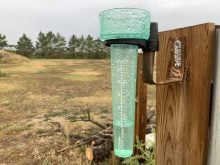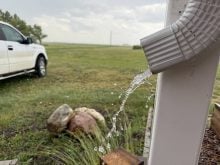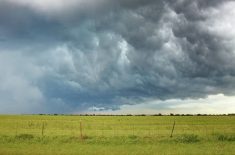With scarce water, big heat and short grass, the 2023 southern Alberta grazing season has been a slow-rolling disaster.
On July 12, for the second time in 20 years, the Special Areas Board declared a state of agricultural disaster for Special Areas 2, 3 and 4 due to prolonged drought. The Special Areas cover five million acres in east-central Alberta.
On Aug. 8, the Municipal District of Pincher Creek became the 13th in a parade of rural counties and special areas to formally declare a municipal agricultural disaster.
Read Also

Moo translator and methane measures: There’s an app for that
Dalhousie University researchers use artificial intelligence to create new dairy farm apps that analyze cattle sounds and measure methane.
On Aug. 14, the Raymond Irrigation District advised farmers to “make appropriate plans to be finished irrigating by Aug. 28. Please fill your dugouts and stockwaters immediately.”
Rather than pay feed prices exceeding $300 per tonne, some ranchers in east-central Alberta and the Special Areas have sold as much as half their livestock.
During June, July and August, regional soil moisture conditions deteriorated from “severe” to the more alarming “extreme” in provincial reports. At the end of July, toward the foothills south and west of Calgary, pastures were labelled as suffering “extreme’ drought.” August had record heat events and rain was negligible.
Severe drought is a one in 10-year event in this region. Extreme drought happens once in 20 years and exceptional drought occurs about once in 50 years.
George Kueber, Agricultural Financial Services Corporation adjusting manager, toured some of the hard-hit region in mid-August, from Bassano, Strathmore and High River to Lethbridge, Taber and Fort Macleod. He saw serious worry on the faces of ranchers.
“Overall yields are poor. Livestock producers are indicating there is a feed shortage, and they’re making decisions about whether to keep cattle or sell cattle, especially in that Palliser Triangle area,” Kueber said. “If they’re going to keep cattle, they may need to turn them into a crop [to feed].”
By Aug, 20, that was already happening. Well over 400 AFSC clients had hungry cattle grazing in hay fields. Nearly 2,000 had claims as annual crops were used for grazing or silage.
“It’s close to twice the average, and two-thirds more than normal at this point,” Kueber said.
Perspective
West of Nanton and along the Highway 22 Cowboy Trail, M.D. of Ranchland Reeve Ron Davis worries about the 2023 outlook for ranching.
Two grazing co-ops in the Ranchland area, with about 14,000 cattle, recently “cut the stocking rates quite dramatically,” said Davis. “Those cattle will be going home sooner than regular.”
That’s a problem.
“It’s as bad as I’ve seen it, and I’ve been in this country more than 60 years,” Davis said. “They don’t have any pasture left at home. The pasture was used up this spring. They probably have to start feeding with very high-priced feed or, likely, a lot of cattle will be sold.
”We can expect some reduction this winter in the provincial herd. It’s already happening, in fact. A lot of cattle are going to market right now and going to slaughter rather than staying in the cow herd.”
Normally, the district sees lots of fall and winter grazing. Not this winter, he predicts.
“This year those reserves are already gone. The grass is gone. It won’t be there for fall or winter grazing so that will make it that much more difficult for keeping livestock over the winter,” Davis said.
Hopes for the herd and the rural economy now depend on rain and snow before the next growing season.
“If it starts raining, that would be a bright side,” Davis said. “Three years ago we had a tremendous snowstorm that left us three to four feet of snow in late September. It changed things and made the next year work very well. Maybe it could happen again.”
Priorities
Livestock water is the second priority and crop irrigation is third. Top priority is and always will be human consumption, says Raymond Irrigation District chair John McKee. The massive irrigation infrastructure supplies water to 73 towns and villages as well as hundreds of farms and colonies.
Reservoirs for the Raymond system, from Calgary south to Montana, are empty or nearly so. At the high point in spring, they reached about 85 per cent of capacity. Normally that would be supplemented by six to eight inches of rain.
“On our farm, we got four-tenths of an inch to one inch of rain through the growing season,” McKee said. “Fortunately, our farm had a really good snowpack. That melted into the ground, and we grew crops basically on the reserve moisture.”
Water restrictions have been imposed once before, in 2000 and 2001. Usage today is far more efficient and, “with normal rainfall, this is a beautiful area to raise crops.”
But the last five years can be characterized as drought, big rain, drought, big rain, and more extreme drought.
“It’s not like this is new or different. It’s part of the Palliser Triangle,” McKee said. His grandfather bought this land in 1921 and he knows the folklore.
Until more reservoirs are built to provide a multi-year water supply, the cycle will continue, he believes.
“We don’t have a one-year supply. We rely on Mother Nature, and typically she’s agreeable, but she can be about as mean as Father Time is,” he said.















